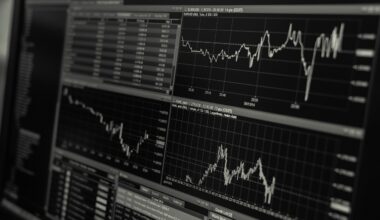Comparing Developed vs. Emerging Markets for Portfolio Diversification
When investing, the comparison between developed markets and emerging markets is crucial. Both types of markets provide unique opportunities and risks for investors seeking international portfolio diversification. Developed markets typically show higher stability and liquidity, making them attractive to conservative investors. Conversely, emerging markets, while more volatile, offer potentially higher returns due to rapid economic growth and underdeveloped market infrastructures. Investors must consider factors such as political stability, economic indicators, and currency risk when choosing their investments. Developed markets such as the U.S., U.K., and Germany are characterized by established regulatory frameworks and mature financial systems. In contrast, emerging markets like Brazil, India, and China often experience fluctuations due to changing political climates and economic development stages. Nevertheless, the diversification benefits that emerging markets can provide cannot be overlooked, as they often exhibit low correlation with developed markets. This potential for uncorrelated returns can lead to a more resilient portfolio over time, particularly during economic downturns when developed markets may suffer. By understanding the differences, investors can make informed decisions regarding their asset allocations.
Risk and Return Profiles
Understanding the risk and return profiles of developed versus emerging markets is essential for any investor. Developed markets are generally characterized by lower risk and more stable returns due to their economic maturity and established financial systems. The historical volatility of these markets is typically less than that of emerging markets. On the other hand, emerging markets are known for their higher risk-to-reward ratio, as rapid economic changes can lead to significant price fluctuations. This higher volatility can present opportunities for aggressive investors willing to accept the risks involved. For instance, while developed markets might yield average annual returns in the range of 5-7%, emerging markets have the potential to provide returns upward of 10% or more, especially in a favorable economic environment. However, the increased potential for returns comes with the price of higher volatility and risk, which can be intimidating for risk-averse investors. Diversifying a portfolio across both developed and emerging markets allows investors to balance potential rewards against associated risks. Thus, understanding these profiles is key to portfolio diversification.
Another important factor in comparing these markets involves economic cycles. Developed markets often have established business cycles, whereas emerging markets tend to experience rapid transitions influenced by various external factors. These cycles can impact investment timing and strategies greatly. For instance, during global economic expansion, emerging markets may outperform due to their ability to capitalize on increased demand for exports. However, during economic downturns, these same markets may face substantial challenges. Developed markets, with their stability, can provide a safe haven during these tough economic periods. Additionally, investors must consider the role of currency risk. In emerging markets, currencies can be extremely volatile, affecting returns when converted back into an investor’s domestic currency. Investors should use hedging strategies to guard against potential losses on currency exchange. When constructing a diversified portfolio, recognizing both domestic and international economic indicators will help investors make more informed, strategic asset allocations. A thorough understanding of each market’s characteristics will strengthen overall investment strategies.
Market Efficiency
Market efficiency is another critical aspect to consider when comparing developed and emerging markets. Developed markets tend to be more efficient, with prices reflecting all available information quickly. This efficiency results from a larger pool of institutional investors, high trading volumes, and advanced technology infrastructures. As a result, the likelihood of finding undervalued or overvalued stocks is generally lower in developed markets. On the contrary, emerging markets often operate under less efficient conditions. Prices may not fully reflect all available information due to lower trading volumes, fewer analysts, and less access to data. Consequently, this inefficiency presents opportunities for investors in emerging markets to identify mispriced assets. Specialized knowledge and strategies can yield substantial returns in these less efficient markets. Furthermore, as emerging markets develop over time, their market efficiencies tend to improve. Investors must be aware of this dynamic change and adapt their investment strategies accordingly. Taking advantage of these inefficiencies through research and analysis can lead to significant diversification benefits and enhanced portfolio performance.
Another compelling reason to consider both developed and emerging markets in a diversified portfolio is the impact of global events. Global politics, trade agreements, and economic policies can vastly impact markets on different fronts. For example, decisions made in one part of the world can have ripple effects across global economies, affecting both developed and emerging markets differently. Investors must remain vigilant and informed about global economic trends, as geopolitical risks can affect these markets in various ways. Trade tensions, for instance, may disproportionately affect emerging markets heavily reliant on exports. Therefore, having exposure to both market types allows investors to mitigate potential losses during global disruptions by balancing their portfolios accordingly. Moreover, diversifying into emerging markets may provide a hedge against inflation, particularly when developed markets are facing stagnation or slow growth. Overall, a comprehensive understanding of the unique factors affecting both developed and emerging markets can empower investors with knowledge for better decision-making.
Conclusion: Strategic Asset Allocation
In conclusion, strategically allocating assets between developed and emerging markets is vital for achieving a well-diversified portfolio. Each market provides distinct advantages and challenges, making it essential for investors to consider their risk tolerance, investment goals, and market conditions. The integration of both market types allows for the potential of superior returns while managing risks effectively. While emerging markets may present higher growth prospects, the stability of developed markets can serve as a strong foundation for overall portfolio health. Investors may wish to consult with financial advisors and conduct thorough research to identify the optimal balance for their specific situations. This combination of strategies and knowledge will ultimately contribute to long-term investment success. Further, it is essential that investors continuously monitor their portfolios and adapt their asset allocations in response to changing market conditions. Regularly reassessing both global trends and individual market performance will help maintain a diversified and resilient investment approach. Expanding awareness in this domain will ensure that diversification strategies remain aligned with an investor’s long-term financial objectives and risk appetite.
Overall, the key to successful investing in international finance lies in the understanding of the characteristics of developed versus emerging markets. Each offers unique opportunities for growth, stability, and risk management. Therefore, by deeply analyzing these factors, investors can construct portfolios that balance the potential of higher returns with the stability required during economic fluctuations. Education and adaptability remain paramount for effective investment strategies. Developing a diversified approach that leverages the strengths of both market types will likely yield more favorable outcomes in the long term. Investors can foster a sustainable investment philosophy founded on the principles of diversification by keeping abreast of market trends, employing informed asset allocations, and maintaining a strong focus on individual investment goals. With this essential understanding of international portfolio diversification, investors are empowered to navigate the complex landscapes of both developed and emerging markets while maximizing their wealth potential.
Adopting a forward-thinking approach will ultimately enhance the potential for success in portfolio diversification. By balancing exposure between developed and emerging markets, investors can capture growth opportunities while reducing risks associated with market volatility. Regular portfolio reviews and assessments will ensure alignment with long-term goals, allowing for timely adjustments in asset allocation based on market conditions. Additionally, leveraging emerging markets’ unique growth prospects alongside the stability of developed markets will create a resilient and flexible investment strategy. This holistic view widens the investment horizon and promotes better decision-making in volatile environments. Through strategic diversification, investors can minimize risks while maximizing returns, significantly enhancing their overall financial health. Understanding the comprehensive landscape of international finance is critical to executing these strategies successfully. In essence, a well-structured investment portfolio that spans both developed and emerging markets enables investors to navigate economic challenges while harnessing the benefits that each market type offers. Such careful crafting of a diversified portfolio will position investors favorably for financial growth over time.


